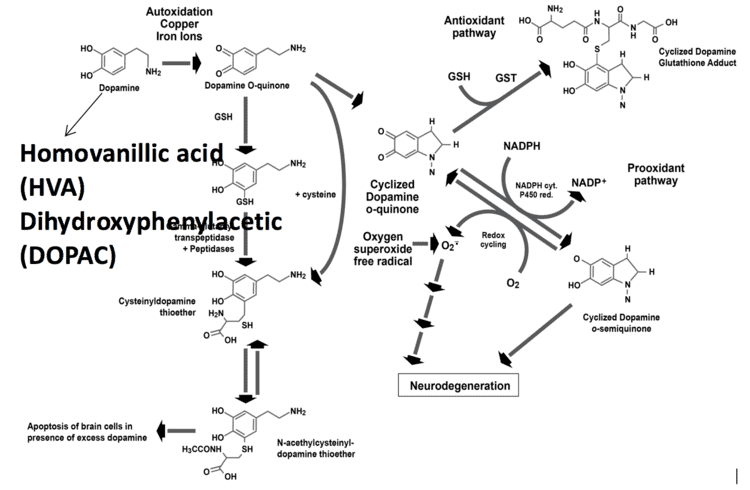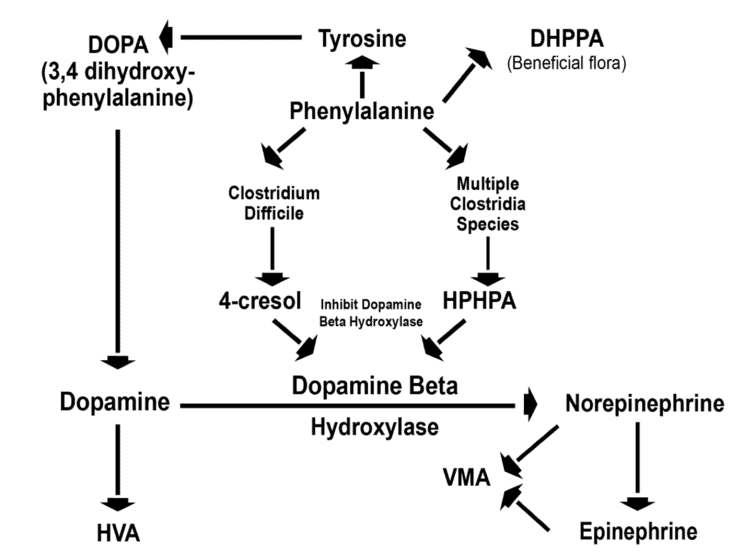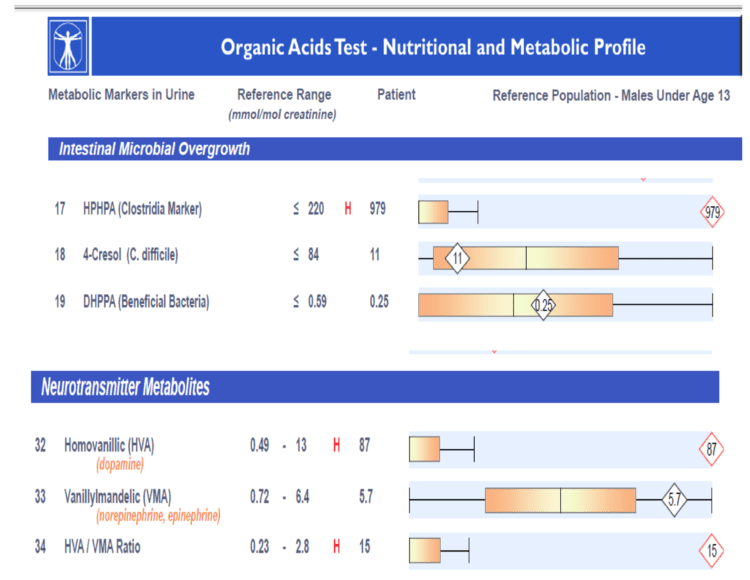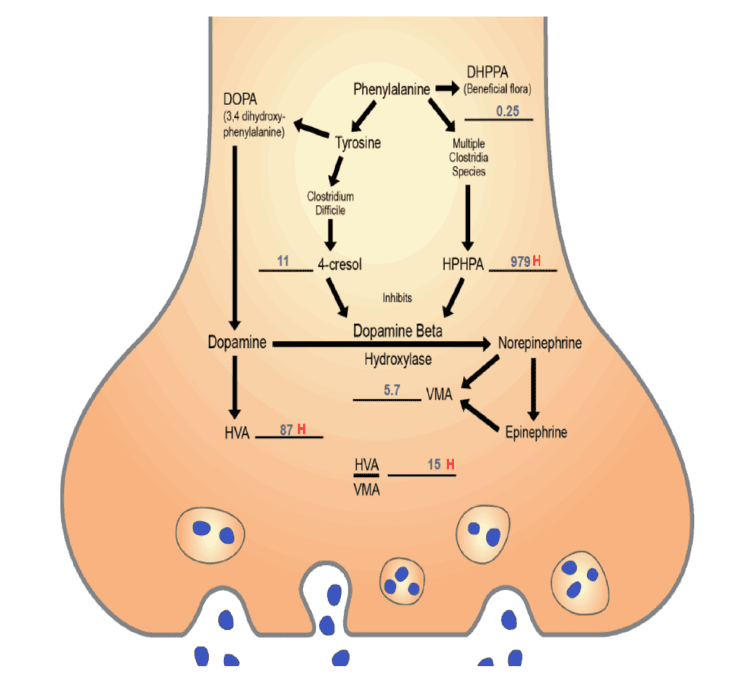Concentrations of the dopamine metabolite homovanillic acid, or HVA, have been reported to be much higher in the urine of children with autism compared to controls. In the same study, severity of autism symptoms was directly related to the concentration of HVA. There was a relation between the urinary HVA concentration and increased agitation, stereotypical behaviors, and reduced spontaneous behavior. Furthermore, vitamin B6, which has been shown to decrease autistic symptoms, decreases urinary HVA concentrations. Excess dopamine has been implicated in the etiology of psychotic behavior and schizophrenia for over 40 years. Drugs that inhibit dopamine binding to dopaminergic receptors have been some of the most widely used pharmaceuticals used as antipsychotic drugs and have been widely used in the treatment of autism. Recent evidence reviewed below indicates that dopamine in high concentrations may be toxic to the brain.

Dopamine is a very reactive molecule compared with other neurotransmitters, and dopamine degradation naturally produces oxidative species (Figure 1). More than 90 percent of dopamine in dopaminergic neurons is stored in abundant terminal vesicles and is protected from degradation. However, a small fraction of dopamine is cytosolic, and it is the major source of dopamine metabolism and presumed toxicity. Cytosolic dopamine (Figure 1) undergoes degradation to form 3,4-dihydroxyphenylacetic acid (DOPAC) and homovanillic acid (HVA) via the monoamine oxidase pathway. Alternatively, dopamine undergoes oxidation in the presence of excess iron or copper (common in autism and schizophrenia) to form dopamine cyclized o-quinone, which is then converted to dopamine cyclized o-semiquinone, depleting NADPH in the process. Dopamine cyclized o-semiquinone then reacts with molecular oxygen to form oxygen superoxide free radical, an extremely toxic oxidizing agent. In the process, dopamine cyclized o-quinone is reformed, resulting in a vicious cycle extremely toxic to tissues producing dopamine, including the brain, peripheral nerves, and the adrenal gland.
It is estimated that each molecule of dopamine cyclized o-quinone produces thousands of molecules of oxygen superoxide free radical in addition to depleting NADPH. The o-quinone also reacts with cysteine residues on glutathione or proteins to form cysteinyl-dopamine conjugates (Figure 1). One of these dopamine conjugates is converted to N-acetylcysteinyl dopamine thioether, which causes apoptosis (programmed cell death) of dopaminergic cells. These biochemical abnormalities cause severe neurodegeneration in pathways that utilize dopamine as a neurotransmitter. Neurodegeneration is due to depletion of brain glutathione and NADPH as well as the overproduction of oxygen superoxide free radicals and neurotoxic N-acetylcysteinyl dopamine thioether. In addition, the depletion of NADPH also results in a diminished ability to convert oxidized glutathione back to its reduced form.
What is the likely cause of elevated dopamine in autism? A significant number of studies have documented increased incidence of stool cultures positive for certain species of Clostridia bacteria in the intestine in children with autism using culture and PCR techniques. All these studies have indicated a disproportionate increase in various Clostridia species in stool samples compared to normal controls. In addition, metabolic testing has identified the metabolites 3-(3-hydroxyphenl)-3-hydroxypropionic acid (HPHPA) and 4-cresol from Clostridia bacteria at significantly higher concentrations in the urine samples of children with autism and in schizophrenia.
Treatment with antibiotics against Clostridia species, such as metronidazole and vancomycin, eliminates these urinary metabolites with reported concomitant improvement in autistic symptoms. In addition, I had noticed a correlation between elevated HPHPA and elevated urine homovanillic acid (HVA). The probable mechanism for this correlation is that certain Clostridia metabolites have the ability to inactivate dopamine beta-hydroxylase, which is needed for the conversion of dopamine to norepinephrine (Figure 2).

Such metabolites are not found at only trace levels. The concentration of the Clostridia metabolite HPHPA in children with autism may sometimes exceed the urinary concentration of the norepinephrine metabolite vanillylmandelic acid (VMA) by a thousand fold on a molar basis and may be the major organic acid in urine in those with severe gastrointestinal Clostridia overgrowth, and even exceed the concentration of all the other organic acids combined. Dopamine beta hydroxylase that converts dopamine to norepinephrine in serum of severely intellectually disabled children with autism was much lower than in those who were higher functioning. Decreased urine output of the major norepinephrine metabolite meta-hydroxyphenolglycol (MHPG) was decreased in urine samples of children with autism, consistent with inhibition of dopamine beta hydroxylase.
Many physicians treating children with autism have noted that the severity of autistic symptoms is related to the concentration of the Clostridia marker 3-(3-hydroxyphenyl)-3-hydroxypropionic acid (HPHPA) in urine. These are probably the children with autism with severe and even psychotic behavior treated with Risperdal® and other anti-psychotic drugs, which block the activation of dopamine receptors by excess dopamine. I have identified a number of species of Clostridia species that produce HPHPA including C. sporogenes, C.botulinum, C. caloritolerans, C. mangenoti, C. ghoni, C.bifermentans, C. difficile, and C. sordellii. All species of Clostridia are spore formers and thus may persist for long periods of time in the gastrointestinal tracts even after antibiotic treatment with oral vancomycin and metronidazole.
How do the changes in brain neurotransmitters caused by Clostridia metabolites alter behavior? The increase in phenolic Clostridia metabolites common in autism significantly decreases brain dopamine beta hydroxylase activity. This leads to overproduction of brain dopamine and reduced concentrations of brain norepinephrine, and can cause obsessive, compulsive, stereotypical behaviors associated with brain dopamine excess and reduced exploratory behavior and learning in novel environments that are associated with brain norepinephrine deficiency. Such increases in dopamine in autism have been verified by finding marked increases in the major dopamine metabolite homovanillic acid (HVA) in urine. The increased concentrations of HVA in urine samples of children with autism are directly related to the degree of abnormal behavior. The concentrations of HVA in the urine of some children with autism are markedly abnormal.
In addition to alteration of brain neurotransmitters, the inhibition of the production of norepinephrine and epinephrine by Clostridia metabolites may have a prominent effect on the production of neurotransmitters by the sympathetic nervous system and the adrenal gland. The major neurotransmitter of the sympathetic nervous system that regulates the eyes, sweat glands, blood vessels, heart, lungs, stomach, and intestine is norepinephrine. An inadequate supply of norepinephrine or a substitution of dopamine for norepinephrine might result in profound systemic effects on physiology. The adrenal gland which produces both norepinephrine and epinephrine might also begin to release dopamine instead, causing profound alteration in all physiological functions. In addition to abnormal physiology caused by dopamine substitution for norepinephrine and dopamine, dopamine excess causes free radical damage to the tissues producing it, perhaps leading to permanent damage of the brain, adrenal glands, and sympathetic nervous system if the Clostridia metabolites persist for prolonged periods of time, if glutathione is severely depleted, and if there is apoptotic damage caused by the dopamine metabolite N-acetylcysteinyl dopamine thioether.
Depletion of glutathione can be monitored in Mosaic Diagnostics Organic Acids Test by tracking the metabolite pyroglutamic acid, which is increased in both blood and urine when glutathione is depleted. In addition, Mosaic Diagnostics also tests the other molecules involved in this toxic pathway, the dopamine metabolite homovanillic acid (HVA), the epinephrine and norepinephrine metabolite VMA and the Clostridia metabolites HPHPA and 4-cresol.
In summary, gastrointestinal Clostridia bacteria have the ability to markedly alter behavior in autism and other neuropsychiatric diseases by production of phenolic compounds that dramatically alter the balance of both dopamine and norepinephrine. Excess dopamine not only causes abnormal behavior but also depletes the brain of glutathione and NADPH and causes a vicious cycle producing large quantities of oxygen superoxide that causes severe brain damage. Such alterations appear to be a (the) major factor in the causation of autism and schizophrenia. The organic acid test (see sample organic acids test report below) now has the ability to unravel a major mystery in the causation of autism, schizophrenia, and other neuropsychiatric diseases, namely the reason for dopamine excess in these disorders.
In the past, some physicians would order the organic acid test once a year or less. With the new knowledge of the mechanism of Clostridia toxicity via inhibition of dopamine beta-hydroxylase, it seems that the control of such toxic organisms needs to monitored much more frequently to prevent serious brain, adrenal gland, and sympathetic nervous system damage caused by excess dopamine and oxygen superoxide. Below is a test report of a child with autism tested with Mosaic Diagnostics Organic Acids Test.

Discussion of Pateint Results
In the graph above, the vertical bar is the upper limit of normal and the patient’s value is plotted inside a diamond (red for abnormal, black for normal). The above results were from a boy with severe autism. The HPHPA Clostridia marker was very high (979 mmol/mol creatinine), about 4.5 times the upper limit of normal. However, the metabolite due to Clostridium difficile was in the normal range, indicating that Clostridium difficile was unlikely to be the Clostridium bacteria producing the high HPHPA. In other words, a different Clostridia species was implicated. The major dopamine metabolite homovanillic acid (HVA) was extremely high (87 mmol/mol creatinine), almost 7 times the upper limit of normal. The major metabolite of epinephrine and norepinephrine, VMA was in the normal range. The HVA/VMA ratio was 15, more than five times higher than the upper limit of normal, indicating a severe imbalance in the production of epinephrine/norepinephrine and that of dopamine. The very high dopamine metabolite, HVA, indicates that the brain, adrenal glands, and sympathetic nervous system may be subject to severe oxidative stress due to superoxide free radicals and that brain damage due to severe oxidative stress might result if the Clostridia bacteria are left untreated. Below the same patient’s results are displayed in a form that is related to the metabolic pathways. This graphical result now appears on all organic acid results from Mosaic Diagnostics.

Reference
- Shaw W. Increased urinary excretion of a 3-(3-hydroxyphenyl)-3-hydroxypropionic acid (HPHPA), an abnormal phenylalanine metabolite of Clostridia spp. in the gastrointestinal tract, in urine samples from patients with autism and schizophrenia. Nutr Neurosci. 2010 Jun;13(3):135-43.





